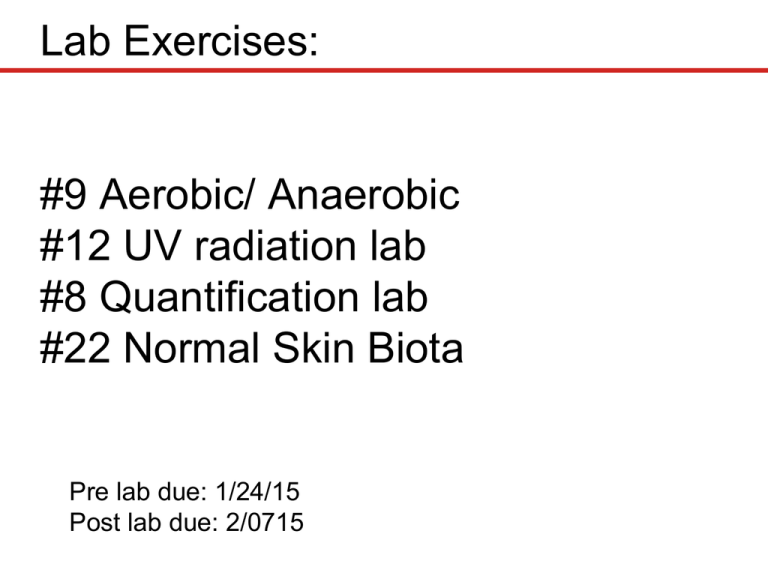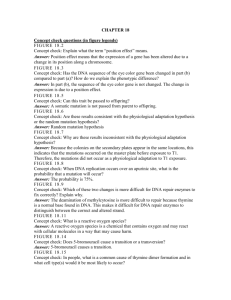Lab Exercises: #9 Aerobic/ Anaerobic #12 UV radiation lab #8 Quantification lab
advertisement

Lab Exercises: #9 Aerobic/ Anaerobic #12 UV radiation lab #8 Quantification lab #22 Normal Skin Biota Pre lab due: 1/24/15 Post lab due: 2/0715 Oxygen Requirements Boil nutrient agar to drive off O2; cool to just above solidifying temperature; innoculate; gently swirl • Growth demonstrates organism’s O2 requirements Providing Appropriate Atmospheric Conditions Aerobic • Most obligate aerobes and facultative anaerobes can be incubated in air (~20% O2) • Broth cultures shaken to provide maximum aeration • Many medically important bacteria (e.g., Neisseria, Haemophilus) grow best with increased CO2 • Some are capnophiles, meaning require increased CO2 • One method is to incubate in candle jar Microaerophilic • Require lower O2 concentrations than achieved by candle jar • Can incubate in gas-tight container with chemical packet • Chemical reaction reduces O2 to 5–15% Providing Appropriate Atmospheric Conditions Anaerobic: obligate anaerobes sensitive to O2 • Anaerobic containers useful if microbe can tolerate brief O2 exposures; can also use semisolid culture medium containing reducing agent (e.g., sodium thioglycolate) • Reduce O2 to water • Anaerobic chamber provides more stringent approach 8.3. Induced Mutations Radiation: two types • Ultraviolet irradiation forms thymine dimers • Covalent bonds between adjacent thymines – Cannot fit into double helix; distorts molecule – Replication and transcription stall at distortion – Cell will die if damage not repaired – Mutations result from cell’s SOS repair mechanism • X rays cause single- and double-strand breaks in DNA – Double-strand breaks often produce lethal deletions • X rays can alter nucleobases Copyright © The McGraw-Hill Companies, Inc. Permission required for reproduction or display. Thymine dimer Thymine Thymine Covalent bonds Ultraviolet light Sugar-phosphate backbone Repair of Thymine Dimers Several methods to repair damage from UV light • Photoreactivation: light repair • Enzyme uses energy from light • Breaks covalent bonds of thymine dimer • Only found in bacteria Copyright © The McGraw-Hill Companies, Inc. Permission required for reproduction or display. Photoreactivation Covalent bonds 5' 3' G C G A T T G A C G C G C T AA C T G C 3' 3' G C G A T T G A C G C G C T A A C T G C • Excision repair: dark repair • Enzyme removes damage • DNA polymerase, DNA ligase repair 5' 3' 5' Thymine dimer distorts the DNA molecule. 5' An enzyme uses visible light to break the covalent bond of the thymine dimer, restoring the DNA to its original state. Excision repair Covalent bonds 5' 3' 3' G C G A TT G A C G C G C T AA C T G C Cut 5' 3' 5' Cut A T T GA G G C C G C G C T A A C T G C 5' 3' Thymine dimer distorts the DNA molecule. 3' 5' 3' G C G A T T G A C G C G C T A A C T G C 5' An enzyme removes the damaged section by cutting the DNA backbone on either side of the thymine dimer. The combined actions of DNA polymerase and DNA ligase fill in and seal the gap. Repair of Thymine Dimers Several methods to repair damage from UV light (continued…) • SOS repair: last-ditch repair mechanism • • • • Induced following extensive DNA damage Photoreactivation, excision repair unable to correct DNA and RNA polymerases stall at unrepaired sites Several dozen genes in SOS system activated – Includes a DNA polymerase that synthesizes even in extensively damaged regions – Has no proofreading ability, so errors made – Result is SOS mutagenesis 4.8. Methods to Detect and Measure Microbial Growth Viable cell counts: cells capable of multiplying • Can use selective, differential media for particular species • Plate counts: single cell gives rise to colony • Plate out dilution series: 30–300 colonies ideal Copyright © The McGraw-Hill Companies, Inc. Permission required for reproduction or display. Adding 1 ml of culture to 9 ml of diluent results in a 1:10 dilution. Original bacterial culture to 9 ml diluent 1:10 dilution to 9 ml diluent 1:100 dilution 50,000 cells/ml 5,000 cells/ml 500 cells/ml 1 ml Too many cells produce too many colonies to count. 1 ml Too many cells produce too many colonies to count. 1 ml Too many cells produce too many colonies to count. to 9 ml diluent 1:1,000 dilution 50 cells/ml 1 ml Between 30–300 cells produces a countable plate. to 9 ml diluent 1:10,000 dilution 5 cells/ml 1 ml Does not produce enough colonies for a valid count. 4.8. Methods to Detect and Measure Microbial Growth • Plate counts determine colony-forming units (CFUs) Copyright © The McGraw-Hill Companies, Inc. Permission required for reproduction or display. Spread-plate method Solid agar Incubate Culture, diluted as needed 0.1–0.2 ml Bacterial colonies appear only on surface. Spread cells onto surface of pre-poured solid agar. Pour-plate method 0.1–1.0 ml Melted cooled agar Incubate Add melted cooled agar and swirl gently to mix. Some colonies appear on surface; many are below surface. 22.1. Anatomy, Physiology, and Ecology Skin prevents entry, regulates body temperature, restricts fluid loss, senses environment • Epidermis: surface layer made from layers of flat cells • Outermost are dead and filled with water-resistant keratin • Constantly flake off and replaced Copyright © The McGraw-Hill Companies, Inc. Permission required for reproduction or display. • Dermis: nerves, glands, blood and lymphatic vessels • Subcutaneous tissue: fat, other cells that support skin Hairs Epidermis Sebaceous gland Arrector pili (smooth muscle) Skin Dermis Hair follicle Nerve Vein Artery Sweat gland Fat Subcutaneous tissue (hypodermis) 22.1. Anatomy, Physiology, and Ecology • Outermost layers bathed in secretions • Sweat delivered via fine tubules from sweat glands; evaporates, leaves salty residue that inhibits microbes • Sebaceous glands open into hair follicles, secrete oily sebum that keeps hair and skin soft, water-repellant • Normal microbiota adapted to dry, salty, cool habitat • Use substances in sweat, sebum as nutrients; byproducts inhibit other microbes (e.g., breakdown of sebum yields fatty acids that are toxic to many bacteria) • Too dry, salty, acidic, and toxic for most pathogens – Those that tolerate often shed with dead skin cells • Normal microbiota can be troublesome • Body odor from bacterial breakdown of odorless sweat • Some are opportunistic pathogens 22.1. Anatomy, Physiology, and Ecology • Different regions of skin have different inhabitants • Drier back may have only 1,000 bacteria per cm2 compared with more than 10 million in groin, armpit • Most microbial inhabitants in three groups • Diphtheroids: oily regions (forehead, upper chest, back) – Propionibacterium most common: obligate anaerobes, grow within hair follicles • Staphylococci: salt-tolerant, use nutrients and produce antimicrobial substances active against other Gram-positive bacteria • Malassezia: tiny lipiddependent yeasts 22.2. Bacterial Skin Diseases Few bacteria invade intact skin directly • Strands of hair provide route of invasion Acne Vulgaris: commonly begins at puberty • Signs and Symptoms • Enlarged sebaceous glands, increased sebum secretion • Hair follicle epithelium thickens, sloughs off in clumps • Blockage yields large accumulations of sebum, produces blackheads and whiteheads • Causative Agent • Propionibacterium acnes, which multiplies in sebum 22.2. Bacterial Skin Diseases Acne Vulgaris (continued…) • Pathogenesis • Metabolic products cause inflammatory response • Neutrophils recruited, release enzymes that damage follicle wall; follicle may burst to yield abscess – Collection of pus (living and dead neutrophils, bacteria, and tissue debris) • Epidemiology • Most people have P. acnes on skin throughout lives • Increased incidence of acne during puberty likely due to excess sebum production due to increased hormones • Treatment and Prevention • Usually mild; medications available • Squeezing lesions ill-advised, can rupture follicles 22.2. Bacterial Skin Diseases Hair Follicle Infections: generally mild • Signs and Symptoms • Folliculitis is inflammation, causes red bumps (pimples) • If infection extends to adjacent tissues, yields furuncle – Localized redness, swelling, tenderness, pain – Pus may drain from the boil • May worsen to form carbuncle – Large area of redness, swelling, pain, draining pus – Fever often present • Causative Agent • Commonly caused by Staphylococcus aureus – Produces identifying coagulase and clumping factor, which are virulence factors 22.2. Bacterial Skin Diseases Hair Follicle Infections (continued…) • Pathogenesis • S. aureus attaches to cells of hair follicle, multiplies, spreads to sebaceous glands • Infection produces inflammatory response – Neutrophils recruited – Plug forms from inflammatory cells, dead tissue • Deeper spread yields furuncle • Can increase to form carbuncle • If infection enters bloodstream, can spread, reach heart, bones, brain Staphylocci S. aureus- pathogen, many virulence factors S. epidermidis- commensal, not typically pathogenic Differentiating Staphylococci species: • Mannitol Salt Agar (MSA) plates • S. aureus can ferment mannitol – Results in yellow color change • S. epidermidis can NOT ferment mannitol – Results in no color change (agar remains pink/red) • Coagulase test • S. aureus coagulates rabbit plasma • S. epidermidis can NOT coagulate rabbit plasma





